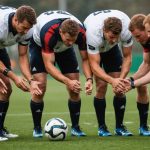Mental imagery is not just for athletes; it's a powerful tool for anyone looking to improve muscle conditioning. This technique can elevate your workouts by enhancing focus, boosting motivation, and promoting muscle memory. By visualizing your movements and desired outcomes, you harness mental strength that complements your physical efforts. Discover how to integrate mental imagery into your fitness routine and unlock your full potential. Take a step towards smarter training and see the results transform your approach to muscle conditioning.
Understanding Mental Imagery
Mental imagery is a powerful tool in sports, often equated with visualization techniques. It involves creating vivid pictures in the mind to enhance performance. This cognitive training method is crucial for athletes, as it bridges the gap between mental preparation and physical execution.
Also to see : Unlocking Muscle Recovery: The Impact of Sleep Pattern Adjustments
Definition and Importance
Mental imagery refers to the process of visualizing actions or scenarios without physical movement. It is fundamental in sports for improving focus, building confidence, and refining skills. Athletes use it to mentally rehearse techniques, which can lead to better performance during actual events.
Brain Function and Muscle Performance
Engaging in mental imagery activates similar brain areas as physical practice, reinforcing neural pathways. This phenomenon suggests that visualization techniques can enhance muscle memory and coordination, effectively priming the body for action. By simulating the experience, athletes can improve their reaction times and decision-making skills.
Topic to read : Unlocking Focus: The Effects of Mindfulness Meditation on Workout Concentration
Psychological Theories
Several psychological theories support the use of mental imagery. The psychoneuromuscular theory posits that mental practice strengthens the neural connections involved in movement. The symbolic learning theory suggests that mental imagery aids in understanding movement patterns and strategies. These theories underline the importance of cognitive training in sports, providing a scientific basis for its widespread use.
Psychological Effects of Mental Imagery
Mental imagery provides profound psychological benefits for athletes, particularly in enhancing motivation and focus. By vividly visualizing success, athletes can bolster their intrinsic motivation, driving them to persist through challenges. This mental rehearsal cultivates a sense of achievement, fostering a positive mindset that is crucial for sustained performance.
Motivation and Focus
Mental imagery acts as a powerful motivational tool. Athletes who regularly engage in visualization techniques often report increased determination and clarity in their goals. By mentally rehearsing scenarios, they can maintain focus under pressure, ensuring that their attention remains directed towards achieving peak performance.
Self-Efficacy and Performance
Self-efficacy, the belief in one's capability to execute tasks, is significantly enhanced through mental imagery. When athletes visualize themselves successfully performing tasks, they reinforce their confidence in their abilities. This increased self-efficacy translates into improved performance, as athletes are more likely to take on challenges and persist in the face of adversity.
Case Studies
Numerous case studies highlight the psychological transformations athletes undergo through mental imagery. For instance, Olympic athletes often credit visualization techniques as key to their mental resilience and success. These examples underscore the transformative power of mental imagery in sports, providing compelling evidence of its psychological benefits.
Physiological Effects of Mental Imagery
Mental imagery significantly impacts muscle conditioning by interacting with neuromuscular pathways. When athletes engage in visualization, their brains activate similar neural circuits as those involved in physical practice. This activation strengthens the connections within these pathways, enhancing performance without actual movement.
Interaction with Neuromuscular Pathways
The brain's engagement during mental imagery mimics that of physical exercises. This process helps in reinforcing neuromuscular pathways, which are crucial for muscle coordination and control. By repeatedly visualizing specific movements, athletes can condition their muscles to respond more effectively, even before physical execution.
Physiological Changes in Visualization
Research indicates that mental imagery can lead to physiological changes akin to those observed during physical practice. Studies have shown increased muscle activation during mental rehearsal, suggesting that visualization can contribute to muscle strength and endurance. This phenomenon allows athletes to prepare their bodies for intense physical demands without the risk of overtraining.
Research Findings
Numerous studies support the idea that mental imagery can enhance muscle performance. For example, athletes who regularly practice visualization demonstrate improved muscle response times and coordination. These findings highlight the potential of mental imagery as a powerful tool for performance enhancement, offering a non-invasive method to boost athletic capabilities.
Techniques for Effective Mental Imagery
To harness the full potential of mental imagery, athletes can explore various imagery training techniques. These methods are designed to refine their skills and enhance performance through visualization exercises.
Types of Imagery Techniques
Athletes can engage in different types of imagery, such as visual and kinesthetic. Visual imagery involves creating detailed mental pictures of successful performances, while kinesthetic imagery focuses on the sensations and movements involved in executing specific skills. By combining these techniques, athletes can develop a comprehensive mental rehearsal routine.
Creating Effective Imagery Routines
To create an effective imagery routine, athletes should follow a structured approach:
- Set clear goals for each session.
- Visualize in a quiet environment to minimise distractions.
- Engage all senses to make the imagery vivid and realistic.
- Practice regularly to reinforce neural pathways.
Integrating Mental Imagery into Training
Incorporating mental imagery into regular training sessions can significantly boost an athlete’s performance. By dedicating time to imagery training, athletes can mentally rehearse their techniques, leading to improved focus and execution during competitions. This integration helps in building confidence and resilience, essential traits for success in sports.
Practical Applications in Training
Mental imagery is a vital component of training programs, allowing athletes to refine their skills beyond physical practice. By integrating mental imagery into their routines, athletes can enhance their performance and gain a competitive edge.
Athletes can incorporate mental imagery into their training programs by setting aside dedicated time for visualization. This practice enables them to mentally rehearse performance routines, focusing on specific skills and scenarios. For instance, visualizing a perfect dive or a flawless sprint can help athletes mentally prepare for competition.
Several athletes have successfully used mental imagery to boost their performance. For example, many elite gymnasts visualize their routines before stepping onto the mat, ensuring they are mentally prepared for each move. This technique has been credited with improving focus and execution during high-pressure situations.
Balancing physical training with mental imagery practices is crucial for optimal results. Athletes should aim to complement their physical workouts with regular imagery sessions. This balance ensures that both the mind and body are prepared for the demands of competition, leading to enhanced performance routines and overall success. By integrating mental imagery into their training, athletes can unlock their full potential and achieve their goals.
Scientific Research on Mental Imagery
Scientific research provides substantial empirical evidence supporting the effectiveness of mental imagery in sports. Various research studies have demonstrated that mental imagery can significantly enhance athletic performance, often rivalling traditional training methods.
Several key studies have explored the impact of mental imagery on performance. For instance, research has shown that athletes who incorporate visualization techniques into their routines often experience improvements in focus, coordination, and execution. These studies underscore the value of mental imagery as a complementary tool to physical training.
A comparative analysis of mental imagery versus traditional training methods reveals intriguing insights. While physical practice is indispensable, mental imagery offers unique benefits by engaging the brain's neural pathways without physical exertion. This approach can lead to enhanced muscle memory and quicker response times, providing athletes with a competitive edge.
Meta-analyses further bolster the case for mental imagery, highlighting its positive effects on performance. By reviewing a wide range of literature, these analyses confirm that athletes who regularly engage in mental imagery tend to outperform those who rely solely on physical training. This body of research underscores the transformative potential of mental imagery in sports.
Examples of Mental Imagery in Action
Mental imagery is a key component in the training regimens of many successful athletes. Real-world examples highlight its effectiveness. Olympic swimmer Michael Phelps, for instance, is renowned for his use of visualization techniques. Before each race, Phelps mentally rehearses every stroke, turn, and finish, ensuring he is fully prepared. This practice has been pivotal in his record-breaking performances.
In the realm of gymnastics, Simone Biles uses mental imagery to envision her routines. By visualizing each flip and landing, she enhances her focus and execution under pressure. This mental preparation has contributed to her numerous gold medals and world titles.
Fitness trainers often advocate for mental imagery, citing its benefits in improving performance. Testimonials from trainers suggest that athletes who incorporate visualization into their routines often report heightened confidence and reduced anxiety. These success narratives underscore the transformative power of mental imagery in sports.
Such athlete stories and feedback from trainers provide compelling evidence of mental imagery's effectiveness. By mentally rehearsing their performances, athletes can refine their skills and achieve remarkable results, illustrating the practical application of this powerful cognitive tool.
Exercises for Implementation
Engaging in mental imagery exercises can significantly enhance athletic skills. Beginners can start by dedicating short, focused sessions to visualizing simple movements. For instance, a novice runner might imagine their stride and breathing rhythm. This practice builds a foundation for more complex visualizations.
Techniques for Novices and Experts
For seasoned athletes, advanced practical techniques involve detailed visualizations of entire routines. A gymnast, for example, might mentally rehearse a full sequence, focusing on each flip and landing. This comprehensive approach helps refine techniques and boost performance during competitions.
Tracking Progress in Mental Imagery
To effectively track progress in mental imagery practice, athletes can use tools like journals or apps. Recording details of each session, such as duration and focus areas, allows athletes to monitor improvements and adjust techniques accordingly. This structured approach ensures continuous skill enhancement and maximises the benefits of mental imagery exercises.
Potential Benefits for Athletes and Fitness Enthusiasts
Mental imagery offers numerous performance benefits for athletes and fitness enthusiasts across various sports. By visualising successful performances, individuals can improve their focus, coordination, and execution, leading to enhanced outcomes during competitions and workouts.
Injury Recovery and Rehabilitation
Mental imagery plays a crucial role in injury recovery and rehabilitation. Athletes can use visualization to maintain muscle memory and coordination during periods of physical inactivity. By mentally rehearsing movements, they can prepare their bodies for a smoother transition back to physical activity, reducing the risk of re-injury.
Building Mental Resilience
Engaging in mental imagery practices fosters mental resilience and adaptability. Athletes who regularly visualize overcoming challenges develop a stronger mindset, enabling them to cope with pressure and setbacks more effectively. This mental preparation is vital for achieving long-term success in sports, as it equips individuals with the tools to bounce back from adversity.
Incorporating mental imagery into training routines not only enhances physical performance but also strengthens the mental fortitude necessary for sustained success. By leveraging the power of visualization, athletes and fitness enthusiasts can unlock their full potential and achieve their goals with confidence.
Visual Aids and Resources
Visual aids such as diagrams and charts play a crucial role in enhancing the comprehension of mental imagery techniques. These tools help athletes and coaches visually interpret complex concepts, making them more accessible and easier to understand. By breaking down mental imagery processes into visual components, learners can better grasp the nuances of cognitive training.
Educational Materials
Numerous educational materials are available for those interested in exploring mental imagery further. Books and apps dedicated to sports psychology often include sections on visualization techniques, providing readers with structured guidance and exercises. Websites offer a wealth of information, including articles and videos that delve into the science behind mental imagery and its application in sports.
Visual aids and resources not only support learning but also encourage the practical application of mental imagery techniques. By integrating these tools into training routines, athletes can enhance their mental rehearsal practices, leading to improved performance and greater success in their respective sports.











